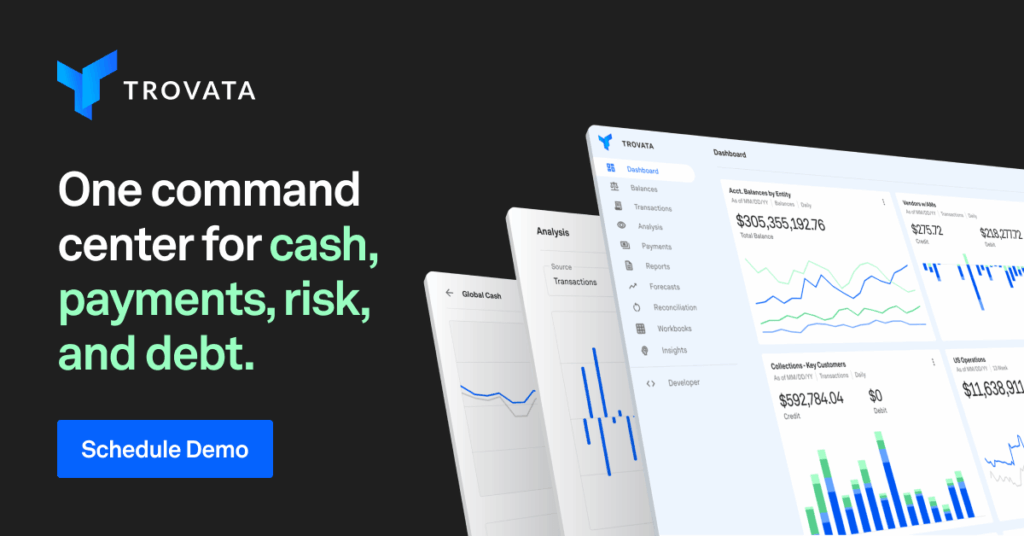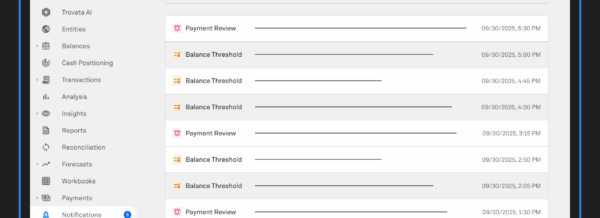Retail treasury is built on volume and velocity. Thousands of stores, millions of transactions, dozens of banking partners, and constant movement of cash, every day, across every region. For finance leaders overseeing this web of activity, visibility and control often come at a steep operational cost.
That’s where modern store banking solutions come in. By centralizing how treasury teams manage cash, bank accounts, and armored carrier logistics across retail locations, solutions like Store Banking, included in Trovata TMS, are transforming what multi-location cash management looks like on the ground.
Here we’re taking a look at how treasury teams can streamline operations, reduce manual workload, and strengthen governance across hundreds, or even thousands of retail locations using store banking technology.
Table of Contents
The Challenge of Multi-Location Cash Management
Retail businesses often operate on razor-thin margins and massive transaction volume. Each store or service location might have its own deposit accounts, cash pickup schedules, merchant IDs, and smart safes. Multiply that by hundreds of stores, and it’s easy to see how treasury complexity scales faster than the teams managing it.
Most treasury departments struggle with at least one of the following challenges:
- Limited visibility. Store-level banking details such as account numbers, carriers, and schedules are often scattered across spreadsheets or regional systems.
- Inconsistent processes. Different regions or divisions follow their own procedures for opening accounts, scheduling pickups, or changing bank services.
- Slow response times. Service requests for new safes, deposit changes, or carrier issues can take days or weeks to process when they’re managed via email.
- Compliance risk. Without standardized workflows and checklists, it’s difficult to ensure store-level processes align with treasury policy or service-level agreements.
Traditional treasury systems weren’t designed to handle this level of operational granularity. They track balances and transactions, but not the real-world logistics of retail cash management.
What Store Banking Does Differently
Store banking is purpose-built for treasury teams managing retail or multi-location operations. It bridges the gap between cash in motion and cash in system, offering a single source of truth for every store’s banking, carrier, and cash-handling data.
At its core, Store Banking provides three critical capabilities:
Centralized Data Management
Treasury can search, access, and map complete information for every retail location worldwide, including address, bank relationships, vaults, safes, carriers, merchant IDs, and contact details.
Each record is fully searchable and user-definable, allowing teams to create custom fields, tags, and workflows for their business.
Workflow Automation and Compliance
Requests related to store operations, from bank account changes to carrier schedule updates, are managed through built-in workflows with checklists and SLAs. This not only ensures consistency and auditability but also helps treasury measure service performance across vendors and internal teams.
Operational Visibility and Reporting
Dashboards and reporting tools allow treasury to view store-level activity in real time.
Users can instantly see carrier usage, pickup schedules, merchant devices, or whether a location is open, pending, or temporarily closed for renovation.
The result is a unified system of record for all store-level banking and cash activity, something legacy systems were never designed to handle.
How Treasury Teams Use Store Banking in Practice
Let’s explore how these capabilities translate into tangible outcomes for retail treasury operations.
1. Streamlining Bank Account and Service Management
Opening, modifying, or closing accounts across a retail network can be an administrative maze. Each request might require coordination between treasury, the store, the bank, and the carrier.
With the Store Banking workflow engine in Trovata TMS, treasury can standardize the entire process:
- Define required fields, documents, and approvals.
- Assign tasks automatically to responsible parties.
- Track progress and completion in real time.
If a store requests a new deposit account, treasury can immediately see what’s pending, what’s approved, and what’s awaiting documentation, all within one system. That transparency minimizes email bottlenecks and ensures policy compliance.
2. Managing Carriers, Vaults, and Smart Safes
Retail cash logistics involve multiple third parties, including armored carriers, vault providers, and smart safe vendors. Each has its own pickup schedules, contact lists, and service agreements. Store Banking consolidates all that data into one accessible platform, meaning treasury can:
- View carrier assignments and pickup times by location.
- Track vault IDs and smart safe serial numbers.
- Flag issues or outages for resolution through workflow tickets.
This not only improves operational continuity but also enables treasury to compare vendor performance across regions, identifying which carriers consistently meet SLAs and which fall short.
3. Simplifying Merchant Services Oversight
From POS terminals to merchant IDs, retail stores rely on a wide array of payment devices. Store Banking helps map those devices to specific locations and bank accounts, giving treasury full visibility into where each terminal is deployed and which merchant IDs are active.
That means faster reconciliation when issues arise and reduced risk of lost or unaccounted devices, a common source of leakage in large retail networks.
4. Enabling Smarter Decision-Making with Searchable Data
Traditional spreadsheets make it nearly impossible to analyze trends across hundreds of locations. Store Banking changes that. Treasury can instantly query the system:
- “Show all stores using Bank X for deposits.”
- “Which locations have pickups scheduled less than three times a week?”
- “List all stores with pending account changes.”
This searchability turns operational data into insight. For example, treasury might discover redundant accounts or underutilized carrier services, leading to opportunities to consolidate and reduce costs.
Why Multi-Location Visibility Matters Now
The role of treasury in retail has expanded from oversight to optimization. It’s not enough to simply manage bank accounts and cash; treasury is expected to drive efficiency, reduce fees, and support business growth. That requires visibility and granularity at every level.
When each store operates semi-independently, blind spots multiply quickly. A delay in one region’s deposits might not appear until reconciliation, by which point liquidity positions could already be inaccurate.
Store Banking addresses that by giving treasury continuous insight into:
- The status of each location (open, closed, under renovation).
- Banking relationships and accounts tied to each store.
- Current pickup schedules and carrier dependencies.
- Compliance with treasury’s standard operating procedures.
In effect, treasury gains a real-time operating map of retail cash flow, something that was once only achievable through (substantial) manual effort.
Store Banking: a How-To Guide for Treasury Teams
Implementing Store Banking doesn’t require a full treasury transformation. Most retail teams can start small and expand functionality as they see results. Here’s how to approach it:
Step 1: Centralize Location Data
Gather key information for all stores, including addresses, bank accounts, carriers, and safes, and load it into the system.This creates a single, structured database that replaces static spreadsheets.
Step 2: Standardize Workflows
Use a tool like Trovata TMS for its Store Banking workflow module to create templates for common tasks:
- New store openings
- Bank account modifications
- Carrier or vault changes
- Merchant device updates
Each workflow can include checklists, SLAs, and automated task assignments to enforce consistency.
Step 3: Define Service Level Metrics
Establish measurable service targets (e.g., ‘account setup within five business days’). Store Banking automatically tracks progress, helping treasury identify bottlenecks and measure vendor performance.
Step 4: Expand Visibility Across Teams
Once core data and workflows are live, open access to other functions such as finance, operations, and compliance, to encourage collaboration and transparency. Each team can benefit from seeing the same data in real time.
Step 5: Use Analytics to Drive Continuous Improvement
With all your store banking data searchable and reportable, treasury can track patterns over time:
- Which regions experience the most delays?
- Which carriers cost the most per pickup?
- How many accounts are inactive or redundant.
These insights translate directly into operational savings and better liquidity control.
From Managing Cash to Powering Strategic Growth
Retail treasury has always been operationally heavy. But with the right technology, it can become a strategic advantage, delivering both control and agility.
Store Banking enables teams to:
- Eliminate manual tracking and email-based workflows.
- Gain real-time visibility into every store’s banking setup and carrier logistics.
- Enforce consistent standards across regions and vendors.
- Free up treasury bandwidth for analysis, forecasting, and decision support.
For treasurers managing multi-location operations, you can’t optimize what you can’t see. Store Banking delivers the visibility, structure, and automation needed to move from reactive management to proactive strategy.
In a retail environment where margins are thin and efficiency is everything, that’s not just better treasury, it’s better business.
To see how Store Banking with Trovata TMS could transform your retail cash management operations, book a demo today.




